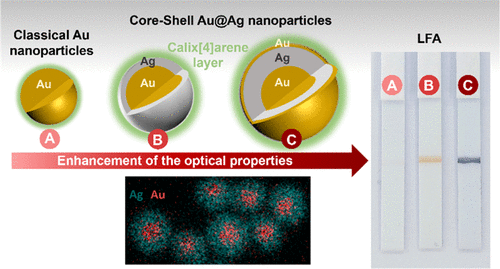Published on March 8, 2024
– Updated on April 29, 2025
Tailored Ultrastable Core–Shell Au@Ag Nanoparticles for Enhanced Colorimetric Detection in Lateral Flow Assays, by Bryan Gosselin, Gilles Bruylants and Ivan Jabin - First published: 05 March 2024
Tailored Ultrastable Core–Shell Au@Ag Nanoparticles for Enhanced Colorimetric Detection in Lateral Flow Assays
 In the quest for more effective colorimetric reporters compared with traditional gold nanoparticles (AuNPs), a family of Au@Ag core–shell nanoparticles was designed and synthesized using a seed growth-mediated approach starting from commercial 37 nm AuNPs. This method enabled precise control over the thickness of the silver shell by employing hydroquinone for the reduction of silver and citrate for stabilization of the resulting core–shell particles. Core–shell NPs with an Ag shell of 7 nm (Au@Ag5NPs) and 18 nm (Au@Ag10NPs) were synthesized, resulting in orange and milky yellow suspension, respectively. Additionally, the impact of an external gold layer on Au@Ag10NPs (Au@Ag10@AuNPs), which significantly altered their optical properties from milky yellow to gray, was investigated. The core–shell Au@AgNPs exhibited substantially higher molar extinction coefficients than their parent AuNPs: from 3.5-fold for Au@Ag5NPs and 9-fold for Au@Ag10NPs and Au@Ag10@AuNPs. Subsequently, all core–shell NPs were functionalized with a calix[4]arene layer, imparting superior stability against external stresses, such as dispersion in PBS, when compared to NPs functionalized with traditional ligands. This calixarene coating enabled the covalent bioconjugation of antibodies on all NP types without inducing noticeable aggregation. Their performance as colorimetric reporters was evaluated in a lateral flow assay for troponin I detection, demonstrating positive signals down to 1 ng/mL, surpassing the detection limit of the parent gold NPs (2.5 ng/mL). Notably, the gray color of the core–shell Au@Ag10@AuNPs provided strong contrast against the white NC membrane, facilitating T-line visualization even at low signal intensity. Despite the lack of optimization of our LFA, it competes with the limit of quantification of commercial LFAs for troponin I detection, offering the potential for the development of a highly sensitive assay. The diverse core–shell NPs employed in this study form a library of colorimetric reporters with distinct optical properties, paving the way for multiplexed detection systems targeting multiple proteins simultaneously and enhancing diagnostic reliability. Furthermore, the choice of colorimetric reporters allows tailoring the detection range based on the pertinent limit of quantification desired for the analyte, dictated by the reporter’s light extinction properties.
In the quest for more effective colorimetric reporters compared with traditional gold nanoparticles (AuNPs), a family of Au@Ag core–shell nanoparticles was designed and synthesized using a seed growth-mediated approach starting from commercial 37 nm AuNPs. This method enabled precise control over the thickness of the silver shell by employing hydroquinone for the reduction of silver and citrate for stabilization of the resulting core–shell particles. Core–shell NPs with an Ag shell of 7 nm (Au@Ag5NPs) and 18 nm (Au@Ag10NPs) were synthesized, resulting in orange and milky yellow suspension, respectively. Additionally, the impact of an external gold layer on Au@Ag10NPs (Au@Ag10@AuNPs), which significantly altered their optical properties from milky yellow to gray, was investigated. The core–shell Au@AgNPs exhibited substantially higher molar extinction coefficients than their parent AuNPs: from 3.5-fold for Au@Ag5NPs and 9-fold for Au@Ag10NPs and Au@Ag10@AuNPs. Subsequently, all core–shell NPs were functionalized with a calix[4]arene layer, imparting superior stability against external stresses, such as dispersion in PBS, when compared to NPs functionalized with traditional ligands. This calixarene coating enabled the covalent bioconjugation of antibodies on all NP types without inducing noticeable aggregation. Their performance as colorimetric reporters was evaluated in a lateral flow assay for troponin I detection, demonstrating positive signals down to 1 ng/mL, surpassing the detection limit of the parent gold NPs (2.5 ng/mL). Notably, the gray color of the core–shell Au@Ag10@AuNPs provided strong contrast against the white NC membrane, facilitating T-line visualization even at low signal intensity. Despite the lack of optimization of our LFA, it competes with the limit of quantification of commercial LFAs for troponin I detection, offering the potential for the development of a highly sensitive assay. The diverse core–shell NPs employed in this study form a library of colorimetric reporters with distinct optical properties, paving the way for multiplexed detection systems targeting multiple proteins simultaneously and enhancing diagnostic reliability. Furthermore, the choice of colorimetric reporters allows tailoring the detection range based on the pertinent limit of quantification desired for the analyte, dictated by the reporter’s light extinction properties.
